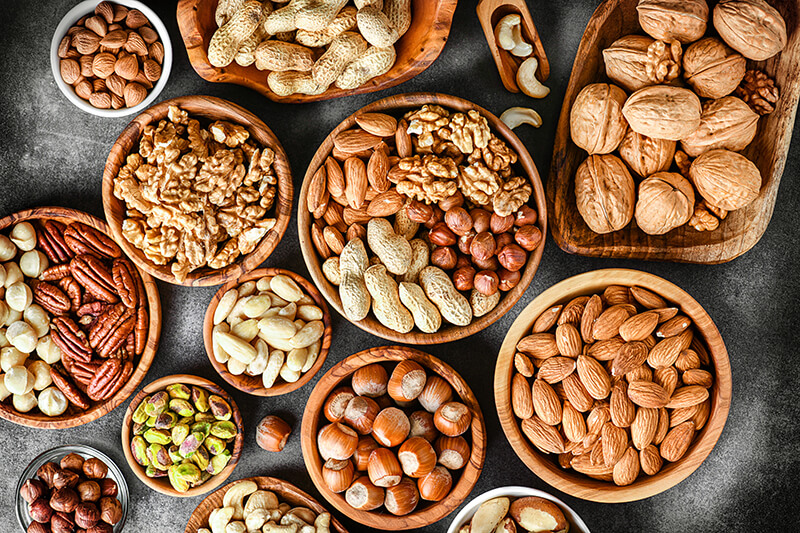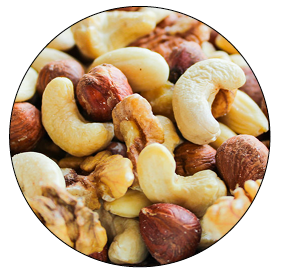Cracking Open the Story of Nuts
Students investigate a variety of nuts, discover how and where they are grown, and explore their nutritional benefits.

Background
Lesson Activities
Recommended Companion Resources
Credits
Author
Lynn Wallin | National Center for Agricultural Literacy (NCAL)
Acknowledgements
- Photo Credit: Mixed Nuts "Bowl of nuts" by msaari is licensed under CC BY-NC-SA 2.0
- Photo Credit: Pistachios "IMG_0072" by gurms is licensed under CC BY-ND 2.0
- Photo Credit: Pine Nuts "_MG_8040" by babbagecabbage is licensed under CC BY 2.0
Sources
- https://www.healthline.com/nutrition/are-nuts-fruits
- https://www.thespruceeats.com/what-are-nuts-1328632
- https://health.gov/our-work/food-nutrition/2015-2020-dietary-guidelines/guidelines/appendix-3/
- https://www.mayoclinic.org/diseases-conditions/heart-disease/in-depth/nuts/art-20046635
- https://uspecans.org/how-pecans-are-grown/
- https://www.cancerfightersthrive.com/7-nutty-facts-about-nuts/
- https://www.fcs.uga.edu/news/story/pecan-enriched-diet-shown-to-reduce-cholesterol
Standards
Texas Content Area Standards
-
ELA: 4.110.6.b.1
Developing and sustaining foundational language skills: listening, speaking, discussion, and thinking- oral language. The students develops oral language through listening, speaking, and discussion.
- ELA: 4.110.6.b.1.D: work collaboratively with others to develop a plan of shared responsibilities
-
Social Studies: 3.113.14.c.4
Geography. The student understands the concepts of location, distance, and direction on maps and globes. The student is expected to:
- Social Studies: 3.113.14.c.14.D: interpret and create visuals, including graphs, charts, tables, timelines, illustrations, and maps
-
ELA: 5.110.7.b.13
Inquiry and research: listening, speaking, reading, writing, and thinking using multiple texts. The student engages in both short-term and sustained recursive inquiry processes for a variety of purposes.
- ELA: 5.110.7.b.13.C: identify and gather relevant information from a variety of sources
- ELA: 5.110.7.b.13.E: demonstrate understanding of information gathered
- ELA: 5.110.7.b.13.H: use an appropriate mode of delivery, whether written, oral, or multimodal, to present results
-
Social Studies: 3.113.14.c.14
Social studies skills. The student applies critical-thinking skills to organize and use information acquired from a variety of valid sources, including technology. The student is expected to:
- Social Studies: 3.113.14.c.14.C: interpret oral, visual, and print material by sequencing, categorizing, identifying the main idea, distinguishing between fact and opinion, identifying cause and effect, comparing, and contrasting
-
Social Studies: 3.113.14.c.15
Social studies skills. The student communicates in written, oral, and visual forms. The student is expected to:
- Social Studies: 3.113.14.c.15.D: express ideas orally based on knowledge and experiences
-
Social Studies: 4.113.15.c.19
Social studies skills. The student applies critical-thinking skills to organize and use information acquired from a variety of valid sources, including technology. The student is expected to:
- Social Studies: 4.113.15.c.19.C: analyze information by applying absolute and relative chronology through sequencing, categorizing, identifying cause-and-effect relationships, comparing, contrasting, finding the main idea, summarizing, making generalizations and predictions, and drawing inferences and conclusions;
- Social Studies: 4.113.15.c.19.D: organize and interpret information in outlines, reports, databases, and visuals, including graphs, charts, timelines, and maps
-
Social Studies: 4.113.15.c.21
Social studies skills. The student communicates in written, oral, and visual forms. The student is expected to:
- Social Studies: 4.113.15.c.21.C: express ideas orally based on research and experiences
- Social Studies: 4.113.15.c.21.D: create written and visual material such as journal entries, reports, graphic organizers, outlines, and bibliographies
-
Social Studies: 5.113.16.c.23
Social studies skills. The student applies critical-thinking skills to organize and use information acquired from a variety of valid sources, including technology. The student is expected to:
- Social Studies: 5.113.16.c.23.C: analyze information by applying absolute and relative chronology through sequencing, categorizing, identifying cause-and-effect relationships, comparing, contrasting, finding the main idea, summarizing, making generalizations and predictions, and drawing inferences and conclusions
- Social Studies: 5.113.16.c.23.D: organize and interpret information in outlines, reports, databases, and visuals, including graphs, charts, timelines, and maps
-
Social Studies: 5.113.16.c.25
Social studies skills. The student communicates in written, oral, and visual forms. The student is expected to:
- Social Studies: 5.113.16.c.25.C: express ideas orally based on research and experiences
- Social Studies: 5.113.16.c.25.D: create written and visual material such as journal entries, reports, graphic organizers, outlines, and bibliographies
-
Science: 4.112.6.b.3
Scientific and engineering practices. The student develops evidence-based explanations and communicates findings, conclusions, and proposed solutions. The student is expected to:
- Science: 4.112.6.b.3.A: develop explanations and propose solutions supported by data and models
- Science: 4.112.6.b.3.B: communicate explanations and solutions individually and collaboratively in a variety of settings and formats
-
Science: 4.112.6.b.4
Scientific and engineering practices. The student knows the contributions of scientists and recognizes the importance of scientific research and innovation for society. The student is expected to:
- Science: 4.112.6.b.4.B: research and explore resources such as museums, libraries, professional organizations, private companies, online platforms, and mentors employed in a science, technology, engineering, and mathematics (STEM) field to investigate STEM careers
-
Science: 5.112.7.b.3
Scientific and engineering practices. The student develops evidence-based explanations and communicates findings, conclusions, and proposed solutions. The student is expected to:
- Science: 5.112.7.b.3.A: develop explanations and propose solutions supported by data and models
- Science: 5.112.7.b.3.B: communicate explanations and solutions individually and collaboratively in a variety of settings and formats
-
Science: 5.112.7.b.4
Scientific and engineering practices. The student knows the contributions of scientists and recognizes the importance of scientific research and innovation for society. The student is expected to:
- Science: 5.112.7.b.4.B: research and explore resources such as museums, libraries, professional organizations, private companies, online platforms, and mentors employed in a science, technology, engineering, and mathematics (STEM) field to investigate STEM careers
-
ELA: 3.110.5.b.1
Developing and sustaining foundational language skills: listening, speaking, discussion, and thinking--oral language. The student develops oral language through listening, speaking, and discussion. The student is expected to:
- ELA: 3.110.5.b.1.C: speak coherently about the topic under discussion, employing eye contact, speaking rate, volume, enunciation, and the conventions of language to communicate ideas effectively
-
ELA: 3.110.5.b.7
Response skills: listening, speaking, reading, writing, and thinking using multiple texts. The student responds to an increasingly challenging variety of sources that are read, heard, or viewed. The student is expected to:
- ELA: 3.110.5.b.7.E: interact with sources in meaningful ways such as notetaking, annotating, freewriting, or illustrating
- ELA: 3.110.5.b.7.F: respond using newly acquired vocabulary as appropriate
-
ELA: 3.110.5.b.13
Inquiry and research: listening, speaking, reading, writing, and thinking using multiple texts. The student engages in both short-term and sustained recursive inquiry processes for a variety of purposes. The student is expected to:
- ELA: 3.110.5.b.13.C: identify and gather relevant information from a variety of sources
- ELA: 3.110.5.b.13.E: demonstrate understanding of information gathered
- ELA: 3.110.5.b.13.H: use an appropriate mode of delivery, whether written, oral, or multimodal, to present results
-
ELA: 4.110.6.b.6
Comprehension skills: listening, speaking, reading, writing, and thinking using multiple texts. The student uses metacognitive skills to both develop and deepen comprehension of increasingly complex texts. The student is expected to:
- ELA: 4.110.6.b.6.G: evaluate details read to determine key ideas
-
ELA: 4.110.6.b.7
Response skills: listening, speaking, reading, writing, and thinking using multiple texts. The student responds to an increasingly challenging variety of sources that are read, heard, or viewed. The student is expected to:
- ELA: 4.110.6.b.7.E: interact with sources in meaningful ways such as notetaking, annotating, freewriting, or illustrating
- ELA: 4.110.6.b.7.F: respond using newly acquired vocabulary as appropriate
-
ELA: 4.110.6.b.13
Inquiry and research: listening, speaking, reading, writing, and thinking using multiple texts. The student engages in both short-term and sustained recursive inquiry processes for a variety of purposes. The student is expected to:
- ELA: 4.110.6.b.13.C: identify and gather relevant information from a variety of sources
- ELA: 4.110.6.b.13.E: demonstrate understanding of information gathered
- ELA: 4.110.6.b.13.H: use an appropriate mode of delivery, whether written, oral, or multimodal, to present results
-
ELA: 5.110.7.b.1
Developing and sustaining foundational language skills: listening, speaking, discussion, and thinking--oral language. The student develops oral language through listening, speaking, and discussion. The student is expected to:
- ELA: 5.110.7.b.1.D: work collaboratively with others to develop a plan of shared responsibilities
-
ELA: 5.110.7.b.6
Comprehension skills: listening, speaking, reading, writing, and thinking using multiple texts. The student uses metacognitive skills to both develop and deepen comprehension of increasingly complex texts. The student is expected to:
- ELA: 5.110.7.b.6.G: evaluate details read to determine key ideas
-
ELA: 5.110.7.b.7
Response skills: listening, speaking, reading, writing, and thinking using multiple texts. The student responds to an increasingly challenging variety of sources that are read, heard, or viewed. The student is expected to:
- ELA: 5.110.7.b.7.E: interact with sources in meaningful ways such as notetaking, annotating, freewriting, or illustrating
- ELA: 5.110.7.b.7.F: respond using newly acquired vocabulary as appropriate
-
Technology Applications: 126.8.c.1
Computational thinking--foundations. The student explores the core concepts of computational thinking, a set of problem-solving processes that involve decomposition, pattern recognition, abstraction, and algorithms. The student is expected to:
- Technology Applications: 126.8.c.1.C: develop a plan collaboratively and document a plan that outlines specific steps taken to complete a project
-
Technology Applications: 126.8.c.5
Data literacy, management, and representation--collect data. The student uses digital strategies to collect and identify data. The student is expected to:
- Technology Applications: 126.8.c.5.A: identify and collect numerical data such as the price of goods or temperature
- Technology Applications: 126.8.c.5.B: use various search strategies with adult assistance
-
Technology Applications: 126.8.c.6
Data literacy, management, and representation--organize, manage, and analyze data. The student uses data to answer questions. The student is expected to analyze data in graphs to identify and discuss trends and inferences.
- Technology Applications: 126.8.c.6: Data literacy, management, and representation--organize, manage, and analyze data. The student uses data to answer questions. The student is expected to analyze data in graphs to identify and discuss trends and inferences
-
Technology Applications: 126.9.c.1
Computational thinking--foundations. The student explores the core concepts of computational thinking, a set of problem-solving processes that involve decomposition, pattern recognition, abstraction, and algorithms. The student is expected to:
- Technology Applications: 126.9.c.1.A: decompose story problems into smaller, manageable subproblems and discuss and document various solutions to the problems
-
Technology Applications: 126.9.c.6
Data literacy, management, and representation--organize, manage, and analyze data. The student uses data to answer questions. The student is expected to use digital tools to transform and make inferences about data to answer a question.
- Technology Applications: 126.9.c.6: Data literacy, management, and representation--organize, manage, and analyze data. The student uses data to answer questions. The student is expected to use digital tools to transform and make inferences about data to answer a question
-
Technology Applications: 126.10.c.1
Computational thinking--foundations. The student explores the core concepts of computational thinking, a set of problem-solving processes that involve decomposition, pattern recognition, abstraction, and algorithms. The student is expected to:
- Technology Applications: 126.10.c.1.A: decompose a real-world problem into smaller, manageable subproblems using graphic organizers such as learning maps, concept maps, or other representations of data
-
Technology Applications: 126.10.c.6
Data literacy, management, and representation--organize, manage, and analyze data. The student uses data to answer questions. The student is expected to use digital tools to analyze and transform data and make inferences to answer questions.
- Technology Applications: 126.10.c.6: Data literacy, management, and representation--organize, manage, and analyze data. The student uses data to answer questions. The student is expected to use digital tools to analyze and transform data and make inferences to answer questions
 students to make a list of as many different types of edible nuts as they can think of.
students to make a list of as many different types of edible nuts as they can think of.